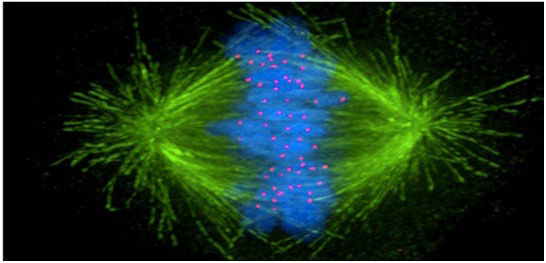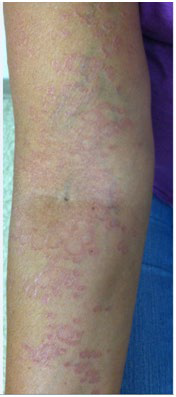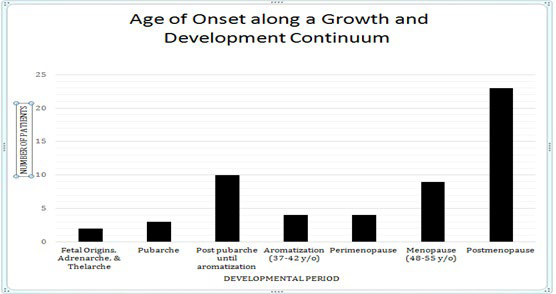1. Thornsberry LA, English JC 3rd. Etiology, diagnosis, and therapeutic management of granuloma annulare: An update. Am J Clin Dermatol. 2013; 14 (4): 279-290. doi: 10.1007/s40257-013-0029-5
2. Kollipara R, Arora C, Reisz C. The phenotype of hormonerelated allergic and autoimmune diseases in the skin: Annular lesions that lateralize. J Allergy (Cairo). 2012; 2012: 604854. doi: 10.1155/2012/604854
3. Piette EW, Rosenbach M. Granuloma annulare: Pathogenesis, disease associations and triggers, and therapeutic options. J Am Acad Dermatol. 2016; 75(3): 467-479. doi: 10.1016/j.jaad.2015.03.055
4. Selmi C, Brunetta E, Raimondo MG, Meroni PL. The X chromosome and the sex ratio of autoimmunity. Autoimmun Rev. (2012); 11(6-7): A531-A537. doi: 10.1016/j.autrev.2011.11.024
5. Hughes GC, Choubey D. Modulation of autoimmune rheumatic diseases by oestrogen and progesterone. Nat Rev Rheumatol. 2014; 10(12): 740-751. doi: 10.1038/nrrheum.2014.144
6. Munoz-Cruz S, Togno-Pierce C, Morales-Montor J. Nonreproductive effects of sex steroids: Their immunoregulatory role. Curr Top Med Chem. 2011; 11(13): 1714-1727. doi: 10.2174/156802611796117630
7. Ghazeeri G, Abdullah L, Abbas O. Immunological differences in women compared with men: Overview and contributing factors. Am J Reprod Immunol. 2011; 66(3): 163-169. doi: 10.1111/j.1600- 0897.2011.01052.x
8. Rubtsov AV, Rubtsova K, Kappler JW, Marrack P. Genetic and hormonal factors in female-biased autoimmunity. Autoimmun Rev. 2010; 9(7): 494-498. doi: 10.1016/j.autrev.2010.02.008
9. Nicklas RB. How cells get the right chromosomes. Science. 1997; 275(5300): 632-637. doi: 10.1126/science.275.5300.632
10. Loncarek J, Kisurina-Evgenieva O, Vinogradova T, et al. The centromere geometry essential for keeping mitosis error free is controlled by spindle forces. Nature. 2007; 450(7170): 745-749. doi: 10.1038/nature06344
11. Hauf S, Watanabe Y. Kinetochore orientation in mitosis and meiosis. Cell. 2004; 119(3): 317–327. doi: 10.1016/j.cell.2004.10.014
12. Hirano T. Chromosome cohesion, condensation, and separation. Annu Rev Biochem. 2000; 69: 115-144. doi: 10.1146/annurev. biochem.69.1.115
13. Di Pietro F, Echard A, Morin X. Regulation of mitotic spindle orientation: An integrated view. EMBO Rep. 2016; 17(8): 1106- 1130. doi: 10.15252/embr.201642292
14. Stinchcombe JC, Griffiths GM. Communication, the centrosome and the immunological synapse. Philos Trans R Soc Lond B Biol Sci. 2014; 369(1650): 20130463. doi: 10.1098/rstb.2013.0463
15. Desai A, Mitchison TJ. Microtubule polymerization dynamics. Annu Rev Cell Dev Biol. 1997; 13: 83-117. doi: 10.1146/annurev.cellbio.13.1.83
16. Joglekar AP, Kukreja AA. How kinetochore architecture shapes the mechanisms of its function. Curr Biol. 2017; 27(6): R816-R824. doi: 10.1016/j.cub.2017.06.012
17. Lampson MA, Grishchuk EL. Mechanisms to avoid and correct erroneous kinetochore-microtubule attachments. Biology (Basel). 2017; 6(1): pii: E1. doi: 10.3390/biology6010001
18. Sarangapani KK, Asbury CL. Catch and release: How do kinetochores hook the right microtubules during mitosis?. Trends Genet. 2014; 30(4): 150-159. doi: 10.1016/j.tig.2014.02.004
19. Ménézo Y, Dale B, Cohen M. DNA damage and repair in human oocytes and embryos: A review. Zygote. 2010; 18(4): 357-365. doi: 10.1017/S0967199410000286
20. Lara-Gonzalez P, Westhorpe FG, Taylor S. The spindle assembly checkpoint. Curr Biol. 2012; 22(22): R966-980. doi: 10.1016/j. cub.2012.10.006
21. Wang RH, Yu H, Deng CX. A requirement for breast-cancer associated gene 1 (BRCA1) in the spindle checkpoint. Proc Natl Acad Sci U S A. 2004; 101(49): 17108-17113. doi: 10.1073/ pnas.0407585101
22. Chao HX, Poovey CE, Privette AA, et al. Orchestration of DNA damage checkpoint dynamics across the human cell cycle. Cell Syst. 2017; 5(5): 445-459. doi: 10.1016/j.cels.2017.09.015
23. Krämer A, Lukas J, Bartek J. Checking out the centrosome. Cell Cycle. 2004; 3(11): 1390-3. doi: 10.4161/cc.3.11.1252
24. Poenie M, Christian L, Tan S, Sykulev Y. Role of the MTOC in T Cell Effector Functions. In: Schatten H. (eds) The Centrosome. Humana Press, Totowa, NJ. 2012.
25. Bustos-Morán E, Blas-Rus N, Martín-Cófreces N, SánchezMadrid F. Orchestrating lymphocyte polarity in cognate immune cell-cell interactions. Int Rev Cell Mol Biol. 2016; 327: 195-261. doi: 10.1016/bs.ircmb.2016.06.004
26. Vertii A, Ivshina M, Zimmerman W, Hehnly H, Kant S, Doxsey S. The centrosome undergoes Plk1-independent interphase maturation during inflammation and mediates cytokine release. Dev Cell. 2016; 37(4): 377-386. doi: 10.1016/j.devcel.2016.04.023
27. Dumontet C, Sikic B. Mechanisms of action of and resistance to antitubulin agents: Microtubule dynamics, drug transport, and cell death. J Clin Oncol. 1999; 17(3): 1061-1070. doi: 10.1200/JCO.1999.17.3.1061
28. De Aguiar Vallim TQ, Tarling EJ, Edwards PA. Pleiotropic roles of bile acids in metabolism. Cell Metab. 2013; 17(5): 657-669. doi: 10.1016/j.cmet.2013.03.013
29. Lindenthal B, Holleran AL, Aldaghlas TA, et al. Progestins block cholesterol synthesis to produce meiosis-activating sterols. FASEB J. 2001; 15(3): 775-784. doi: 10.1096/fj.00-0214com
30. Xu C, Li CY, Kong AN. Induction of phase I, II and III drug metabolism/transport by xenobiotics. Arch Pharm Res. 2005; 28(3): 249-68.doi: 10.1007/BF02977789
31. Soldin OP, Mattison DR. Sex differences in pharmacokinetics and pharmacodynamics. Clin Pharmacokinet. 2009; 48(3): 143-157. doi: 10.2165/00003088-200948030-00001








